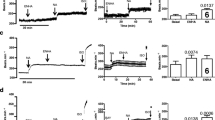Summary
The effects of DPI 201-106 (a novel, cyclic AMP-independent positive inotropic agent with Ca2+-sensitizing and Na+-channel agonistic mechanisms) on myocardial mechanics and energetics were assessed in the excised cross-circulated dog left ventricle. In the first protocol, the relation between left ventricular oxygen consumption (Vo2) and systolic pressure-volume area (PVA) was analyzed before and during administration of DPI 201-106. The reciprocal of the slope of the Vo2-PVA relation has been shown to reflect the contractile efficiency, and the Vo2-intercept consists of the oxygen cost of contractility-dependent excitation-contraction coupling and basal metabolism. DPI 201-106 increased Emax (contractility index) and elevated the Vo2-PVA relation in a parallel manner, i.e., the Vo2-intercept increased without a change in the slope. In the second protocol, the increase in the Vo2-intercept of the Vo2-PVA relation for a unit increase in Emax (i.e., oxygen cost of enhanced contractility) was compared between DPI 201-106 and epinephrine in a paired manner in each heart. Epinephrine significantly abbreviated the time to end systole, whereas DPI 201-106 did not, suggesting that the mechanism of inotropic action differed between the two drugs. However, the oxygen cost of enhanced contractility was the same between the two drugs in each heart. Therefore, DPI 201-106 did not alter the contractile efficiency nor spare the oxygen cost of enhanced contractility as compared to epinephrine under the present experimental conditions. This suggests that the Ca2+-sensitizing effect of DPI 201-106, if any, is too small to spare the oxygen cost of contractility in the blood-perfused, non-failing dog heart.
Similar content being viewed by others
References
Katz AM (1986) Potential deleterious effects of inotropic agents in the therapy of chronic heart failure. Circulation 73 (Suppl III):184–190
Suga H (1990) Ventricular energetics. Physiol Rev 70:247–277
Ruegg JC (1987) Dependence of cardiac contractility on myofibrillar calcium sensitivity. News in Physiol Sci 2:179–182
Suga H, Hisano R, Goto Y, Yamada O, Igarashi Y (1983) Effect of positive inotropic agents on the relation between oxygen consumption and systolic pressure volume area in canine left ventricle. Circ Res 53:306–318
Wu D, Yasumura Y, Nozawa T, Tanaka N, Futaki S, Ohgoshi Y, Yaku H, Suga H (1989) Effect of ouabain on the relation between left ventricular oxygen consumption and systolic pressure-volume area in dog heart. Heart Vessels 5:17–24
Futaki S, Nozawa T, Yasumura Y, Tanaka N, Suga H (1988) New cardiotonic agent, OPC-8212, elevates the myocardial oxygen consumption versus pressure-volume area (PVA) relation in a similar manner to catecholamines and calcium in canine hearts. Heart Vessels 4:153–161
Goto Y, Slinker BK, LeWinter MM (1990) Decreased contractile efficiency and increased nonmechanical energy cost in hyperthyroid rabbit heart. Circ Res 66:999–1011
Burkhoff D, Yue DT, Oikawa RY, Franz MR, Schaefer J, Sagawa K (1987) Influence of ventricular contractility on non-work-related myocardial oxygen consumption. Heart Vessels 3:88–72
Suga H, Sagawa K (1974) Instantaneous pressure-volume relationship and their ratio in the excised, supported canine left ventricle. Circ Res 35:117–126
Ohgoshi Y, Goto Y, Futaki S, Yaku H, Kawaguchi O, Suga H (1990) New method to determine oxygen cost for contractility. Jpn J Physiol 40:127–138
Scholtysik G, Salzmann R, Berthold R, Herzig JW, Quast U, Markstein R (1985) DPI 201-106, a novel cardioactive agent. Combination of cAMP-independent positive inotropic, negative chronotropic, action potential prolonging and coronary dilatory properties. Naunyn Schmiedebergs Arch Pharmacol 329:316–325
Gwathmey JK, Slawsky MT, Briggs GM, Morgan JP (1988) Role of intracellular sodium in the regulation of intracellular calcium and contractility. J Clin Invest 82:1592–1605
Hajjar RJ, Gwathmey JK, Briggs GM, Morgan JP (1988) Differential effect of DPI 201-106 on the sensitivity of the myofilaments to Ca2+ in intact and skinned trabeculae from control and myopathic human hearts. J Clin Invest 82:1578–1584
Suga H, Futaki S, Ohgoshi Y, Yaku H, Goto Y (1989) Arteriovenous oximeter for O2 content difference, O2 saturation, and Hb content. Am J Physiol 257:H1712-H1716
Takahashi K, Endoh M, Taira N (1987) Inotropic versus chronotropic, dromotropic, and coronary vasodilator actions of DPI 201-106, a novel positive inotropic agent, in the dog heart. J Cardiovasc Pharmacol 9:451–460
Snedecor GW, Cochran WG. (1980) Statistical method, 7th edn. Iowa State University Press, Ames, Iowa, pp 365–392
Gibbs CL (1978) Cardiac energetics. Physiol Rev 58:174–254
Ohgoshi Y, Goto Y, Futaki S, Yaku H, Kawaguchi O, Suga H (1991) Increased oxygen cost of contractility in stunned myocardium of dog. Circ Res 69:975–988
Tada M, Yamamoto T, Tonomura Y (1978) Molecular mechanisms of active calcium transport by sarcoplasmic reticulum. Physiol Rev 58:1–79
Kostis JB, Lacy CR, Raia JJ, Dworkin JH, Warner RG, Casazza LA (1987) DPI 201-106 for severe congestive heart failure. Am J Cardiol 60:1334–1339
Ruegg PC, Nuesch E (1987) The effect of a new inotropic agent, DPI 201-106, on systolic time intervals and the electrocardiogram in healthy subjects. Br J Clin Pharmacol 24:453–458
Kihara Y, Gwathmey JK, Grossman W, Morgan JP (1989) Mechanisms of positive inotropic effects and delayed relaxation produced by DPI 201-106 in mammalian working myocardium: Effects on intracellular calcium handling. Br J Pharmacol 96:927–939
Hasenfuss G, Holubarsch C, Just H, Blanchard E, Mulieri LA, Alpert NR (1987) Energetic aspects of inotropic interventions in rat myocardium. Basic Res Cardiol 82 (Suppl):251–259
Nozawa T, Yasumura Y, Futaki S, Tanaka N, Suga H (1988) No significant increase in O2 consumption of KCl-arrested dog heart with filling and dobutamine. Am J Physiol 255:H807-H812
Author information
Authors and Affiliations
Additional information
This study was partly supported by Grants-in-Aid (63570045, 63770073, 63770619, 01770069) for Scientific Research from the Ministry of Education, Science, and Culture, a Research Grant (63A-2) for Cardiovascular Diseases from the Ministry of Health and Welfare of Japan, a Grant from Japan Cardiovascular Research Foundation, and a Grant from Nissan Science Foundation.
Rights and permissions
About this article
Cite this article
Futaki, S., Goto, Y., Ohgoshi, Y. et al. Similar oxygen cost of myocardial contractility between DPI 201-106 and epinephrine despite different subcellular mechanisms of action in dog hearts. Heart Vessels 7, 8–17 (1992). https://doi.org/10.1007/BF01745862
Received:
Revised:
Accepted:
Issue Date:
DOI: https://doi.org/10.1007/BF01745862




